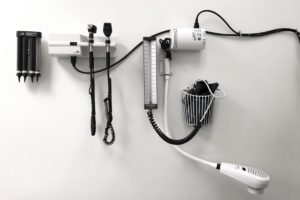Quick Links
What is Kidney Stone Disease?
 Kidney stones are hard substances that may be located in the kidney, ureter, or bladder. They are made up of salts, minerals, and proteins. They are common — about one in ten Americans will have a stone during their lifetime.
Kidney stones are hard substances that may be located in the kidney, ureter, or bladder. They are made up of salts, minerals, and proteins. They are common — about one in ten Americans will have a stone during their lifetime.
There are three basic types of kidney stones:
- Calcium stones are the most common type of stone. They have many different causes including increased dietary calcium intake, hyperparathyroidism, weight loss surgery, increased oxalate consumption, and inflammatory bowel disease.
- Struvite stones, on the other hand, are caused by infection. They are common in patients with a spinal cord injuries. These stones may have living bacteria inside of them.
- Uric acid stones are often caused by increased protein consumption and gout.
Symptoms of Kidney Stone Disease
The symptoms of stones depend upon their location. Stones located in the kidney may be asymptomatic. Stones in the ureter can produce severe back pain radiating to the side or front. Lower ureteral stones may cause urinary frequency or urgency. Stones in the bladder may cause painful urination.
What Causes Kidney Stone Disease?
 There is no one cause of kidney stones — there are many factors that may play a role. Kidney stones form when urine contains high levels of crystal-causing substances.
There is no one cause of kidney stones — there are many factors that may play a role. Kidney stones form when urine contains high levels of crystal-causing substances.
Under certain conditions, these substances that are normally dissolved in the urine become undissolved. This is called precipitation.
Inhibitors are chemicals in your urine that prevent precipitation or stone formation. Some patients have kidney stones because they lack inhibitors. Factors that may increase your risk for kidney stones include:
- Family history
- Dehydration
- Obesity
- Gastrointestinal disease and surgery
- Vegetarian and vegan diets- controversial
Kidney Stone Disease Treatment
There are a number of kidney stone treatments, depending on the size and location of the stone.
Small Stones
 Small stones less than 5 mm can usually pass on their own without intervention. If you have a small stone, you should drink a lot of water to help pass the stone. Medical expulsive therapy or MET uses medication, such as Flomax, to dilate the ureter and ease the stone passage.
Small stones less than 5 mm can usually pass on their own without intervention. If you have a small stone, you should drink a lot of water to help pass the stone. Medical expulsive therapy or MET uses medication, such as Flomax, to dilate the ureter and ease the stone passage.
Studies show, however, that MET does not improve stone passage rates. For this reason, the FDA has not certified any medication to help with the stone passage.
Larger Stones
Larger kidney stones over 5 mm that do not pass after a reasonable period of time require intervention. There are several procedures for the treatment of kidney stones.
Ureteroscopy and Laser Lithotripsy
For stones less than 20 mm in size, and located in the kidney or ureter, the best treatment is ureteroscopy and laser lithotripsy. The procedure is performed under anesthesia on an outpatient basis. The patient usually goes home immediately following the procedure.
After the patient is anesthetized, Dr. Lazare inserts a small fiber-optic telescope into the ureter and he advances the scope to the kidney, if necessary. The stone is visualized and then Dr. Lazare passes a small laser fiber through the scope. He then disintegrates the stone under direct vision with the holmium laser fiber. Small fragments can then be removed with a tiny basket. At the end of the procedure, Dr. Lazare will place a small plastic tube called a stent into your ureter. This stent will be removed in the office about 5 days later.
The risks are low and the procedure is usually performed on an outpatient basis. Stone-free rates are about 85% – 90%.
Extracorporeal Shock Wave Lithotripsy
 Extracorporeal shock wave lithotripsy, or ESWL, is the least invasive means of treating stones in the kidney or in the upper ureter. It is appropriate for stones less than 20mm.
Extracorporeal shock wave lithotripsy, or ESWL, is the least invasive means of treating stones in the kidney or in the upper ureter. It is appropriate for stones less than 20mm.
You lie on the ESWL table and shock waves are then focused upon your kidney stone. The lithotripter machine is outside your body and the procedure is completely non-invasive. The lithotripter effectively disintegrates your stone into small pieces. You must then pass all the stone fragments out of the urinary system via the urine.
The stone-free rate with ESWL is in the 50% to 60% range. The procedure is low risk and completely non-invasive.
Percutaneous Nephrolithotomy
Percutaneous nephrolithotomy or PNL is performed upon patients with stones larger than 20 mm that is usually located in the kidney. The procedure is performed in the hospital under general anesthesia.
With PNL, a small hole is made in the back overlying the kidney with a needle. Dr. Lazare dilates the opening and then inserts a fiber-optic telescope into the kidney. Dr. Lazare is able to see the stone and disintegrate the stone under direct vision with an instrument called a lithotrite. This wand-like instrument creates shock waves that break the stone into small pieces. The stone fragments are then removed with either suction or a basket.
Short of open surgery, the PNL is the most effective procedure for the removal of large kidney stones. The success rate for the percutaneous procedure is over 85 %. The risks include bleeding and infection. In experienced hands, the risks are low. If you undergo this procedure, you will need to stay in the hospital for three days on average.
Video About Kidney Stones
Contact Us
If you are dealing with uncomfortable kidney stones and are looking for an effective treatment, contact us today to schedule your appointment with Dr. Lazare.
